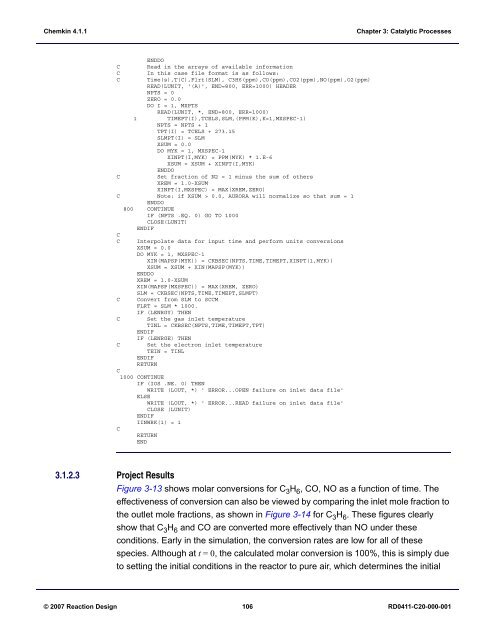Tutorials Manual
Tutorials Manual
Tutorials Manual
Create successful ePaper yourself
Turn your PDF publications into a flip-book with our unique Google optimized e-Paper software.
Chemkin 4.1.1<br />
Chapter 3: Catalytic Processes<br />
C<br />
C<br />
C<br />
C<br />
ENDDO<br />
Read in the arrays of available information<br />
In this case file format is as follows:<br />
Time(s),T(C),Flrt(SLM), C3H6(ppm),CO(ppm),CO2(ppm),NO(ppm),O2(ppm)<br />
READ(LUNIT, '(A)', END=800, ERR=1000) HEADER<br />
NPTS = 0<br />
ZERO = 0.0<br />
DO I = 1, MXPTS<br />
READ(LUNIT, *, END=800, ERR=1000)<br />
1 TIMEPT(I),TCELS,SLM,(PPM(K),K=1,MXSPEC-1)<br />
NPTS = NPTS + 1<br />
TPT(I) = TCELS + 273.15<br />
SLMPT(I) = SLM<br />
XSUM = 0.0<br />
DO MYK = 1, MXSPEC-1<br />
XINPT(I,MYK) = PPM(MYK) * 1.E-6<br />
XSUM = XSUM + XINPT(I,MYK)<br />
ENDDO<br />
Set fraction of N2 = 1 minus the sum of others<br />
XREM = 1.0-XSUM<br />
XINPT(I,MXSPEC) = MAX(XREM,ZERO)<br />
C Note: if XSUM > 0.0, AURORA will normalize so that sum = 1<br />
ENDDO<br />
800 CONTINUE<br />
IF (NPTS .EQ. 0) GO TO 1000<br />
CLOSE(LUNIT)<br />
ENDIF<br />
C<br />
C<br />
C<br />
C<br />
C<br />
Interpolate data for input time and perform units conversions<br />
XSUM = 0.0<br />
DO MYK = 1, MXSPEC-1<br />
XIN(MAPSP(MYK)) = CKBSEC(NPTS,TIME,TIMEPT,XINPT(1,MYK))<br />
XSUM = XSUM + XIN(MAPSP(MYK))<br />
ENDDO<br />
XREM = 1.0-XSUM<br />
XIN(MAPSP(MXSPEC)) = MAX(XREM, ZERO)<br />
SLM = CKBSEC(NPTS,TIME,TIMEPT,SLMPT)<br />
Convert from SLM to SCCM<br />
FLRT = SLM * 1000.<br />
IF (LENRGY) THEN<br />
Set the gas inlet temperature<br />
TINL = CKBSEC(NPTS,TIME,TIMEPT,TPT)<br />
ENDIF<br />
IF (LENRGE) THEN<br />
Set the electron inlet temperature<br />
TEIN = TINL<br />
ENDIF<br />
RETURN<br />
C<br />
1000 CONTINUE<br />
IF (IOS .NE. 0) THEN<br />
WRITE (LOUT, *) ' ERROR...OPEN failure on inlet data file'<br />
ELSE<br />
WRITE (LOUT, *) ' ERROR...READ failure on inlet data file'<br />
CLOSE (LUNIT)<br />
ENDIF<br />
IINWRK(1) = 1<br />
C<br />
RETURN<br />
END<br />
3.1.2.3 Project Results<br />
Figure 3-13 shows molar conversions for C 3 H 6 , CO, NO as a function of time. The<br />
effectiveness of conversion can also be viewed by comparing the inlet mole fraction to<br />
the outlet mole fractions, as shown in Figure 3-14 for C 3 H 6 . These figures clearly<br />
show that C 3 H 6 and CO are converted more effectively than NO under these<br />
conditions. Early in the simulation, the conversion rates are low for all of these<br />
species. Although at t =0, the calculated molar conversion is 100%, this is simply due<br />
to setting the initial conditions in the reactor to pure air, which determines the initial<br />
© 2007 Reaction Design 106 RD0411-C20-000-001
















